Interesting 5 Things To Know About Dolmabahce Palace Before Planning Your Trip
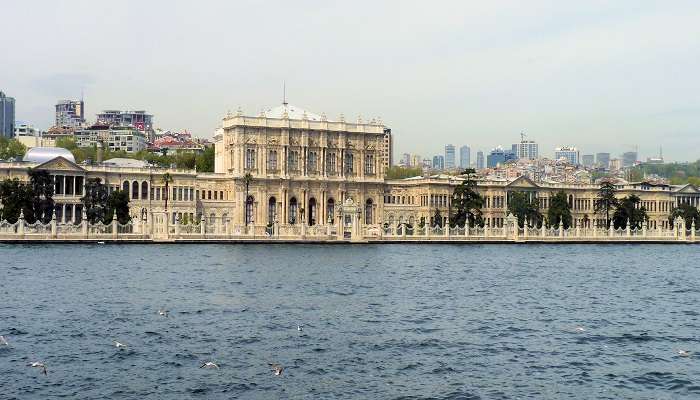
Dolmabahce Palace, nestled on the European shore of the Bosphorus Strait in Istanbul, Turkey, is a masterpiece of Ottoman architecture. Built in the 19th century, it served as the Ottoman Empire’s administrative centre, symbolising the era’s opulence and grandeur. Adorned with intricate details, luxurious furnishings, and sprawling gardens, the palace offers visitors a glimpse into the lavish lifestyle of Ottoman sultans. With its fusion of Eastern and Western architectural styles, Palace continues to captivate tourists worldwide, as a timeless emblem of Turkey’s rich cultural heritage.l
Things To Know About Dolmabahce Palace
These are some of the 5 things you should know about Dolmabahce Palace Istanbul before visiting that will help you make your trip a memorable one and immerse yourself in the grandeur of the past
1. The Grand History Of Palace

The palace’s history dates back to the mid-19th century when Sultan Abdulmecid I commissioned its construction in 1843. He aimed to create a monumental structure that would rival the palaces of Europe and serve as the new administrative centre of the Ottoman Empire, replacing the traditional seat of power at Topkapi Palace. The palace’s construction spanned over a period of 13 years and incurred substantial financial costs, contributing to the empire’s already strained finances. Nevertheless, when completed in 1856, Dolmabahce Palace stood as a testament to the Ottoman Empire’s determination to modernise and assert its presence on the global stage.
Throughout its history, the Palace hosted numerous significant events and dignitaries. It witnessed the end of the Ottoman Empire and the transition to the modern Republic of Turkey. In 1922, Mustafa Kemal Atatürk, the founder of modern Turkey, chose the Palace as his residence during his visits to Istanbul, symbolising the palace’s continued importance in the country’s political landscape. The palace stands as a living testament to the grandeur of the Ottoman Empire and the enduring legacy of Turkey’s rich cultural heritage, inviting visitors to step back in time and experience the splendour of a bygone era.
Must Read: Istanbul Tourist Attractions
2. Magnificent Architecture Of The Dolmabahce Palace
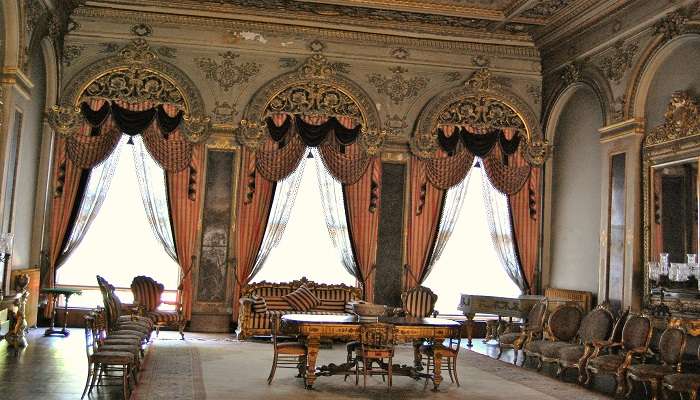
The architecture of Dolmabahce Palace is a breathtaking fusion of various styles, reflecting the eclectic tastes of the Ottoman sultans and the influence of European design trends of the 19th century. Situated on the shores of the Bosphorus in Istanbul, Turkey, the palace is a stunning testament to the empire’s grandeur and sophistication.
Designed by the renowned Armenian architect Garabet Balyan and his son Nigoğayos Balyan, the Palace showcases a harmonious blend of Ottoman, Baroque, Rococo, and Neoclassical architectural elements. The sheer scale and opulence of the palace’s design were intended to rival the grandeur of European royal residences. One of the most striking features of Dolmabahce Palace is its imposing facade, which spans over 600 metres along the Bosphorus shoreline. The palace is divided into three main sections: the Selamlik (Ceremonial Hall), the Haremlik (Private Apartments), and the administrative quarters.
Overall, the architecture of the Palace stands as a testament to the Ottoman Empire’s rich cultural heritage and the enduring legacy of its architectural achievements.
3. Unknown Facts About The Dolmabahce Palace
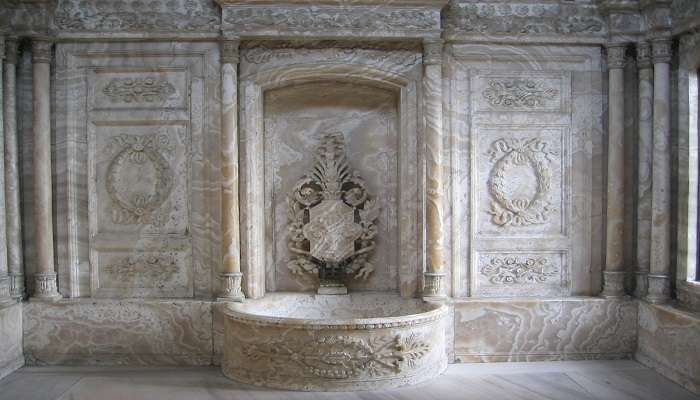
Dolmabahce Palace, with its grandeur and historical significance, holds many fascinating unknown facts that add depth to its allure. One of the most stunning features of the Palace is its crystal staircase, which is adorned with Baccarat crystal balusters. This magnificent staircase, illuminated by natural light filtering through a large chandelier, is a marvel of craftsmanship and opulence.
The palace served as the final residence of Mustafa Kemal Atatürk, the founder of modern Turkey, during his visits to Istanbul. He spent his last days in the palace before passing away on November 10, 1938, in a room that has been preserved as a Dolmabahce Palace museum to this day. The palace boasts one of the largest chandeliers in the world, located in the Ceremonial Hall. Weighing approximately 4.5 tons and adorned with thousands of crystals, this impressive chandelier was a Queen Victoria of England gift to Sultan Abdulaziz.
Another lesser-known fact is that the Dolmabahce Palace was the first palace in Istanbul to be illuminated by electricity. Sultan Abdulhamid II, impressed by the electric lighting he saw during his visit to the Paris World Fair in 1867, ordered the installation of electric lights in the palace in 1879. These lesser-known facts about Dolmabahce Palace enrich its narrative, highlighting its significance as a symbol of Ottoman grandeur.
Suggested Read: Islands Near Istanbul
4. Interesting Legends About The Dolmabahce Palace
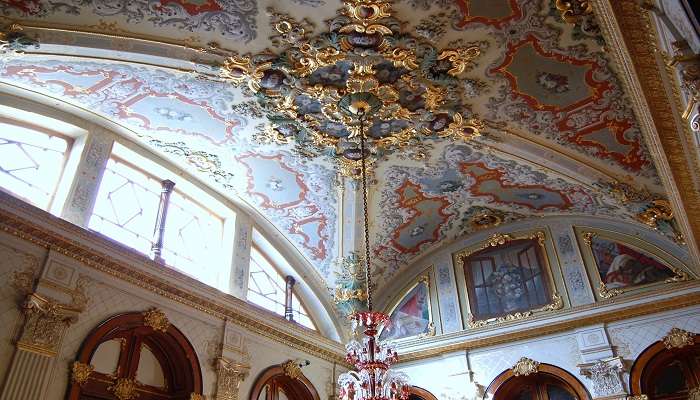
While Dolmabahce Palace is steeped in history, it’s also surrounded by intriguing legends that have been passed down through generations. One legend revolves around the massive crystal chandelier in the Ceremonial Hall of the Palace. According to the tale, the chandelier is cursed, and it is said that anyone who touches it will meet with misfortune or even death. As a result, visitors are cautioned against getting too close to this impressive but allegedly cursed centrepiece. It is rumoured that a hidden treasure is buried somewhere within the grounds of the Palace. Some believe that the Ottoman sultans, fearing invasion or overthrow, concealed their wealth and treasures in secret chambers or tunnels beneath the palace. To this day, treasure hunters and enthusiasts speculate about the existence and location of this elusive fortune.
Another legend surrounding Dolmabahce Palace involves the ghost of Mustafa Kemal Atatürk, the founder of modern Turkey, who spent his final days in the palace before passing away in 1938. It is said that Atatürk’s spirit continues to wander the halls of the palace, watching over his beloved country and occasionally making his presence known to visitors and staff. Whether based on truth or imagination, these legends contribute to the mystique and intrigue surrounding the Palace, transforming it from a mere historical monument into a place of wonder and fascination.
5. Top Things To Do While Exploring The Palace
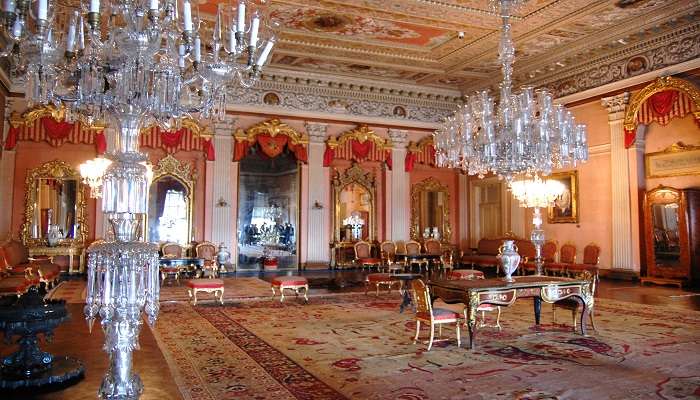
Visiting Dolmabahce Palace offers a rich and immersive experience, allowing visitors to delve into the opulent world of the Ottoman Empire. Some of the top things to do and see while exploring the Palace are embarking on a guided tour of the palace to gain insights into its history, architecture, and significance. Discover the distinct sections of the Palace—the Selamlik, which served as the ceremonial and administrative centre, and the Haremlik, the private quarters of the sultan and his family. Explore the rooms where Mustafa Kemal Atatürk, the founder of modern Turkey, resided during his visits to the Palace. Atatürk’s Museum, located within the palace, preserves his personal belongings, memorabilia, and the room where he passed away.
Marvel at one of the largest chandeliers in the world, located in the Ceremonial Hall of the Palace. Take a leisurely stroll through the palace gardens, which feature ornamental fountains, manicured lawns, and picturesque pathways. From the stunning architecture to the picturesque gardens, plenty of photo-worthy moments are waiting to be captured during your visit.
Further Read: Nightlife In Istanbul
A visit to Dolmabahce Palace is a journey back to the height of the Ottoman Empire’s grandeur and sophistication. From the moment you step through its majestic gates, you are enveloped in a world of opulence, elegance, and historical significance. Next time you plan your trip to Istanbul, Turkey do not forget to include the Palace as one of your spots to visit as it is more than just a tourist attraction—it’s a cultural pilgrimage, a voyage of discovery, and a chance to immerse yourself in the timeless beauty of Turkey’s architectural treasures.
For our editorial codes of conduct and copyright disclaimer, please click here.
Cover Image Source: Casalmaggiore Provincia for Wikipedia Commons
Frequently Asked Questions About Dolmabahce Palace
Why is Istanbul so famous?
Istanbul is a beautiful city in Turkey known for its historical significance. However, it is most famous among tourists for its monuments, vibrant culture, and cuisines.
What is the Grand Bazaar closing time?
The Grand Bazaar closes at 7:00 pm every day and is entirely shut on Sundays. It is advisable for visitors to visit the area in the morning as the crowd is significantly less during that time.
How can tourists reach the bazaar?
The area is well connected by various modes of transport. The Istanbul Airport is at a distance of 47 kms from the Bazaar and it takes approximately 50 minutes to reach by road. Another facility available is the metro which tourists can take from the airport itself to Zeytinburnu and then use a tram from Beyazit to the bazaar.
What are some tips to visit the Grand Bazaar?
Some of the tips to visit the area are firstly that travellers should understand that the bazaar is massive which means that only a few hours are not sufficient to explore the area and hence, an entire day should be given to fulfil the purpose of shopping here.
What are some places to see near the Grand Bazaar?
Some of the most renowned places near the bazaar include the Nuruosmaniye Mosque, Tomb of Mahmut II, 3oth Sultan, Nizam rugs, Iznik works and so on.
Shopping In Chandni Chowk Shopping In Myanmar Shopping In Portugal

With a passion for exploring and travelling to the roads long forgotten, experience the world through enthralling stories and adventures. Join me as I share my experiences at some of the world’s most popular tourist destinations and quench that pestering curiosity with something exciting!











